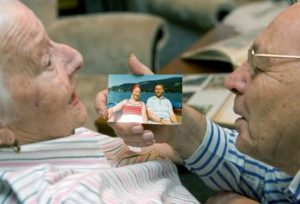Alzheimer’s Disease: How an “Elderly” Disease Progresses
 This serious, incurable disease brings horror to people. After all, it is characterized by the fact that a person gradually completely loses his identity. And statistics is relentless: the number of victims of this disease is steadily increasing, and it is even called the epidemic of the XXI century.
This serious, incurable disease brings horror to people. After all, it is characterized by the fact that a person gradually completely loses his identity. And statistics is relentless: the number of victims of this disease is steadily increasing, and it is even called the epidemic of the XXI century.
What are the forms of Alzheimer’s disease?
As a rule, Alzheimer’s disease (dementia) is considered a disease of the elderly. Indeed, most people suffer from it after the age of 65, and the risk of developing the disease increases with age. But even younger people, 50–60-year-olds can get sick, and even there are cases of the disease after 40 years. At the same time, the manifestations of the disease with early and late onset are different. That is why there are two main forms of the disease: presensual (early) – up to 65 years old and bluewood – after 65, respectively.
There is also a so-called family disease, the beginning of which falls on the age of 40 years. This form is hereditary – several members of one family are sick at once, and the disease is traced in several generations.
Alzheimer’s early form can also be inherited, and it is caused by disorders at the gene level. It is characterized by rapid progression: the patient has a disrupted speech for a short period of time, he ceases to recognize others, loses independence.
There are few cases of early onset. The most common is the cyanide form of the disease. It does not depend on heredity and develops gradually, at the very beginning almost imperceptibly – its first symptoms: forgetfulness, absent-mindedness – are often mistaken for manifestations of age-related features. But year after year, the changes are becoming clearer.
How does the disease develop?
Depending on the manifestations of the disease, the stages of Alzheimer’s disease are distinguished: according to different classifications, from three to seven stages.
When diagnosing, doctors often use a five-stage clinical dementia rating.
Stage 0. The man is practically healthy. He may forget something not too important, a little confuse the details of the event.
Stage 0.5 A person becomes forgetful, but is able to remember what he forgot. He is sometimes confused in time, it is difficult for him to solve complex problems. Here you can already suspect dementia.
Stage 1 – the initial. A person does not remember what happened today or yesterday, forgets what he was just talking about. He cannot find his things, because he does not remember where he put them. Forgets the names of famous people, the names of objects. May be confused in dates. With difficulty oriented in an unfamiliar place.
Healthy Brain and Algeimer’s Disease Brain
The logic of the patient does not suffer yet, but it becomes more difficult for him to make decisions. It is difficult for him to plan his actions. A person copes with his professional duties, but any deviation from the usual routine confuses him.
The logic of the patient does not suffer yet, but it becomes more difficult for him to make decisions. It is difficult for him to plan his actions. A person copes with his professional duties, but any deviation from the usual routine confuses him.
Stage 2 – moderate. Memory suffers more and more. The patient remembers well what happened a long time ago. He begins to get confused in time, “transfers” himself to the past, does not remember how old he is.
Poor oriented on the street, even in his own area.
Does not perceive abstract concepts, is able to understand only concrete things. Disrupted logical thinking.
He can not do his job, loses interest in others, severely limits communication.
At home, he can do simple work, but managing household appliances becomes an overwhelming task for him.
A person is able to take care of himself, but often forgets or does not want to do this, so care and control are needed.
Stage 3 is the last. The patient remains only scattered pieces of memories. He does not remember and does not recognize his relatives, does not understand who he is. Man completely “falls out” of time. Basically, he does not understand where he is at the moment, only sometimes he finds out his house.
The patient’s speech is impaired. He loses all ability to think. Can’t speak and think normally.
The patient is not capable of any, even the most primitive homework, and later he can no longer walk, sit, eat on his own. It is clear that he does not respect personal hygiene.
There is also a classification of Alzheimer’s disease, which includes seven stages. It displays all the same manifestations, but more gradually. So, for example, the last 3rd stage in it is represented by two – severe and extremely difficult.



